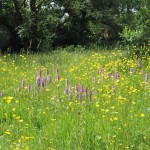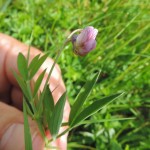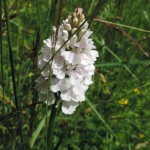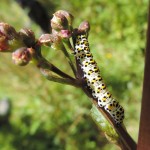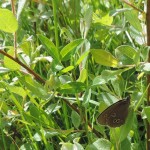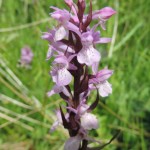Moorend Common near Frieth in Buckinghamshire, designated as a Site of Special Scientific Interest, is a mosaic of ancient woodland and open areas. The geology is almost unique in the Chilterns because the chalk is still covered by layers of clay. The woodlands include areas of beech high forest in Moor Copse, oak-birch woodland and a small area of conifer plantation. The open areas, which used to be more extensive, include areas of acid and marshy grassland, heather and bracken. Due to the mixture of soils and wet areas, over 200 plant species have been recorded on the site including a huge variety of orchids. These, in turn, attract a range of butterflies including rare species such as the Purple Emperor. The Common is owned and managed by the Lane End Parish Council. Chris Ash led a walk here on Wednesday 18 June.
The Common is about 22 hectares in total, split between North, Middle and South meadow areas. Middle meadow is the least spectacular florally, but the ‘ride’ down to South meadow is rich with grasses, rushes and sedges. The walk into South meadow was very wet due to recent heavy rains and the meadow was ablaze with orchids and ‘wet meadow’ flowers and included one remaining Petty Whin specimen. South meadow is dominated by Southern Marsh Orchids and their various hybrids as well as Ragged Robin, Buttercups, Cuckooflower, Sneezewort and numerous grasses. We moved to North meadow where there were hundreds of Heath Spotted Orchids in flower and a large marshy area of rushes, sedges, grasses and wild flowers.
The meadows are rich in bird, butterfly and insect life as can be seen from the species list recorded on the day.
Report by Chris Ash
Pictures by Rob Stallard
| Flora | |
| Achillea ptarmica | Sneezewort (nif – not in flower) |
| Angelica sylvestris | Wild Angelica (nif) |
| Anthroxanthium odoratum | Sweet Vernal Grass |
| Cardamine pratensis | Cuckooflower (almost white) |
| Carex demissa | Common Yellow Sedge |
| Carex Hirta | Hairy Sedge |
| Carex leporina | Oval Sedge |
| Carex panicea | Carnatian Sedge |
| Carex pendula | Pendulous Sedge |
| Carex remota | Remote Sedge |
| Carex sylvatica | Wood sedge |
| Cirsium palustre | Marsh Thistle |
| Dactylorhiza fuchsia | Common Spotted-orchid |
| Dactylorhiza maculata | Heath Spotted-orchid |
| Dactylorhiza sp | Marsh-Orchid and hybrids |
| Danthonia decumbens | Heath-grass |
| Digitalis purpurea | Foxglove |
| Epilobium hirsutum | Great Willowherb (nif) |
| Festuca gigantea | Giant Fescue |
| Galium palustre | Marsh-bedstraw |
| Galium saxatile | Heath Bedstraw |
| Galium uliginosum | Fen Bedstraw |
| Genista anglica | Petty Whin (nif) |
| Geranium robertianum | Herb-Robert |
| Geum urbanum | Wood Avens |
| Hypericum tetrapterum | Square-stalked St John’s-wort |
| Hypochaeris radicata | Cat’s Ear |
| Juncus articulartus | Jointed Rush |
| Juncus conglomeratus | Compact Rush |
| Juncus tenuis | Slender Rush |
| Lathyrus linifolius | Bitter-vetch |
| Lotus pedunculatus | Greater Bird’s-Foot Trefoil |
| Luzula multiflora | Heath Wood-rush |
| Lychnis flos-cuculi | Ragged-Robin (pink and one white) |
| Lysimachia nummularia | Creeping-Jenny (nif) |
| Mentha aquatica | Water mint |
| Nardus stricta | Mat-grass |
| Plantago lanceolata | Ribwort Plantain |
| Potentilla erecta | Tormentil |
| Pulicaria dysenterica | Common Fleabane (nif) |
| Ranunculus acris | Meadow Buttercup |
| Ranunculus flammula | Lesser Spearwort |
| Rhinanthus minor | Yellow-rattle |
| Rosa arvensis | Field-rose |
| Rubus idaeus | Raspberry |
| Scrophularia auriculata | Water Figwort |
| Stachys sylvatica | Hedge Woundwort |
| Stellaria graminea | Lesser Stitchwort |
| Succisa pratensis | Devil’s-bit Scabious |
| Trifolium pratense | Red Clover |
| Trifolium repens | White Clover |
| Vicia tetrasperma | Smooth Tare |
| Birds | |
| Carduelis carduelis | Goldfinch |
| Cyanistes caeruleus | Blue Tit |
| Dendrocopos major | Great Spotted Woodpecker |
| Fringilla coelebs | Chaffinch |
| Milvus milvus | Red Kite |
| Parus major | Great Tit |
| Phylloscopus collybita | Chiffchaff |
| Phylloscopus trochilus | Willow Warbler |
| Poecile palustris | Marsh Tit |
| Prunella modularis | Dunnock |
| Pyrrhula pyrrhula | Bullfinch |
| Sylvia atricapilla | Blackcap |
| Troglodytes troglodytes | Wren |
| Turdus merula | Blackbird |
| Turdus philomelos | Song Thrush |
Lists by Sally Rankin and Sarah White

